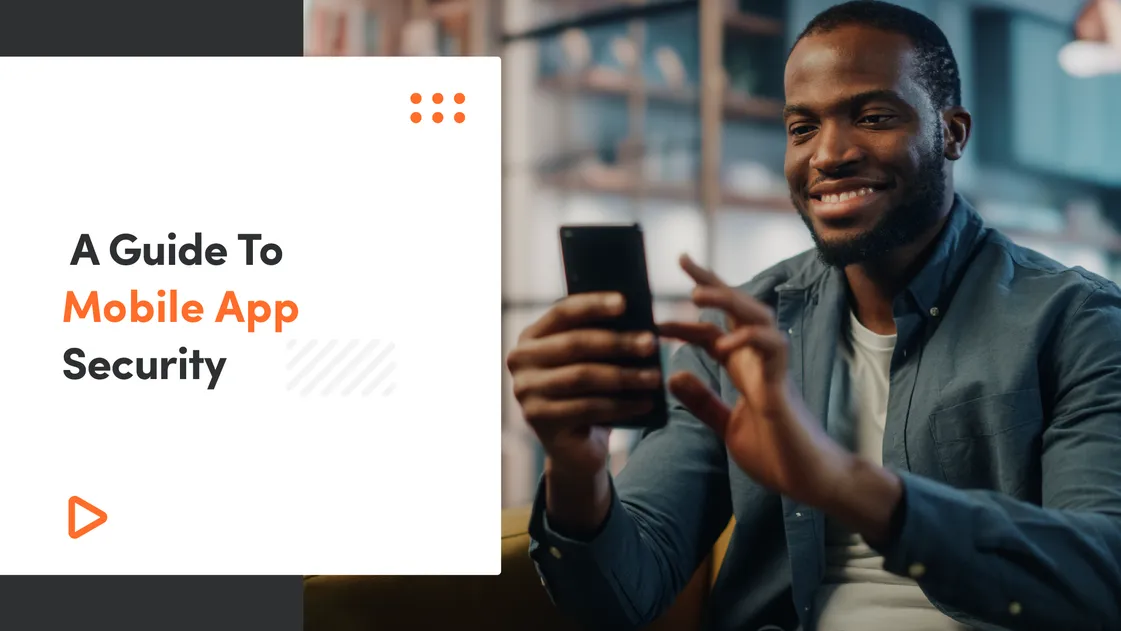Mobile application security is crucial because most users now engage in digital activities through mobile apps.
The latest data from the beginning of 2024 indicate that 69.4% of the total population currently uses mobile devices.
These apps often access sensitive information, necessitating robust security measures. Common security issues include data leaks, weak authentication, inadequate encryption, and lack of secure communication. Weak mobile app security can lead to data breaches, financial losses, brand damage, and intellectual property theft. To address these concerns, businesses should follow best practices such as risk analysis, encryption, multi-factor authentication, and regular penetration testing.
The software security posture of mobile apps on platforms including Android and iOS is the focus of mobile application security. It includes programs that operate on both mobile phones and tablets. Mobile applications are essential for a company's online presence, and many companies rely exclusively on them to communicate with people around the world.
What you will learn from this article:
- Why is mobile application security important for businesses?
- What are some common issues that can affect the security of mobile apps?
- What are some best practices for ensuring mobile app security?
- How can multi-factor authentication enhance mobile app security?
- What are the key considerations when selecting an architectural approach for mobile app development?
- What measures should businesses take to prevent data leaks in mobile apps?
- How can businesses stay ahead of evolving security standards when it comes to mobile app security?
Why mobile application security is important?
The majority of customers' digital activities are now performed on mobile applications rather than traditional desktop ones, which is a new high. These programs have access to a lot of user information, most of it confidential material that has to be secured against unwanted access.
To assist software developers in creating safe apps, all widely used mobile platforms include security measures. Yet frequently it is up to the developer to pick from a wide range of security alternatives. Lack of screening might result in the deployment of security features that are simple for attackers to exploit.

Common issues that affect mobile apps include:
- Storing or inadvertently releasing private information in a way that makes it readable by other mobile apps.
- Putting in place weak authentication and authorization procedures that might be evaded by malicious software or persons
- Using data encryption techniques that have a history of being brittle or readily cracked.
- Sensitive information is being sent online without encryption.
These flaws might be taken advantage of in a variety of ways, for example by malicious software installed on a user's device or by a hacker with access to the same WiFi network as the end user.
Importance already at the level of the secure software development process:
Customers frequently rely on businesses and have faith that they will check their applications for security features before releasing them to the public. But still, tests carried out by IBM turned in some startling information.
Hackers are sufficiently motivated by the aforementioned figures to target security flaws in mobile and web applications, and they attempt to use one or more of the following tactics from unprotected codes. By incorporating security measures from the outset of software development, developers can significantly reduce vulnerabilities and potential exploitation points, thereby preventing costly breaches and reputational damage. This proactive approach not only complies with increasing regulatory requirements but also enhances user experience by delivering robust and reliable applications. That's why ensuring the security of mobile applications at the software development stage is a key element for every company to protect consumers' identity and sensitive data.
The mobile app for security threats - impact of weak security
Here are some of the impacts of weak mobile application security:
Customer Information
Any device or website, including email, banking, social networking sites, etc., can have its login information accessed by hackers. Anubis banking Trojan is a renowned illustration of this type of malware; it infiltrates the user's device by installing corrupted programs, some of which are even housed in legitimate Android app stores. When a device is infected, the Trojan makes it send and receive SMS messages, read contact lists, ask for permission to view the device location, enable push notifications, and find out the IP address of the mobile connection in addition to giving it access to private data on the mobile device.
WhatsApp revealed that its app was susceptible to spyware from the Israeli company NSO group in May 2019. This malware may infect a mobile device by phoning a user on WhatsApp from an unknown number, which is how it spreads to other devices.
Financial Information
When a one-time password is not needed, hackers are more likely to get credit and debit card details to conduct bank transactions. Ginp, a modern variant of the banking Trojan, was found by Kaspersky researchers to be capable of stealing credit card information and user login credentials from a user's device. It can alter banking operations since it can take over the device's SMS functionality. The manipulation of 24 Spanish bank applications by its code was discovered.

Revenue Loss
Accessing premium features of applications is available, particularly in utility and entertainment apps, which are a source of income for the app's owner. Hackers were able to reach the premium features of well-known applications Hulu and Tinder by taking advantage of security flaws in them, according to a 2016 report by the mobile security firm Bluebox, costing the owners of both apps money. For its OTT streaming service at the time, Hulu was charging $7.99 a month for memberships.
IP Theft
Having access to the app's codebase allows hackers to steal the intellectual property of the app's owner's business or to use it to construct their unauthorized copies of the app. An app's likelihood of attracting additional copies on app stores increases with its level of success. For instance, PUBG Mobile and Fortnite both gained popularity but were not yet accessible on Google Play, but a lot of clones of these games quickly appeared due to their high demand. At one point, Google had to inform its customers that authentic Fortnite was not yet available on the Google Play store.
Brand Confidence
In addition to losing important user data, the loss might also result in user data being misused or litigation from harmed parties. While conducting security exercises helps ensure that consumers remain devoted and confident in the company, the drawback is the potential loss of customers' trust in the long run. Businesses need to understand that consumer confidence in their brand is at the core of their operations. So, the rationale for app development should appropriately take this part of the business into account.
10 Common mobile app security issues and risks
A nonprofit organization called the Open Web Application Security Project (OWASP) works to advance application security through disseminating resources, information, and training. The most frequent security issues the organization has uncovered for mobile apps are included in the OWASP mobile top 10. These threats consist of:
- 1. Improper Platform Usage: Poor platform usage, such as inappropriate use of mobile platform capabilities or a failure to make use of the platform's security controls
- 2. Insecure Data Storage: When sensitive data is not encrypted, hackers can access it by using malware or stolen or lost equipment.
- 3. Insecure Communication: The possibility that nefarious parties might intercept confidential information while it is being transferred over open networks.
- 4. Insecure Authentication: Identity management system flaws enabling bad actors to spoof or circumvent authentication to access confidential data or features
- 5. Inadequate Cryptography: Incorrectly or insufficiently applying encryption to safeguard login credentials, private keys, application code, and other sensitive data.
- 6. Insecure Authorization: Permission control issues that allow bad actors to access functionality meant for administrators or other users with more access permissions
- 7. Client Code Quality: Inadequate coding techniques that let external users transmit untrusted (and potentially dangerous) code as inputs to the app, which the app then runs.
- 8. Code Tampering: Failure to identify malicious actors' modifications to the code, resources, or API calls, which alter the application's functionality.
- 9. Reverse Engineering: Malicious actors are unable to recreate the source code, comprehend the inner workings of the app, or stage assaults due to a lack of code obfuscation.
- 10. Extraneous Functionality: The presence of hidden features or unneeded code within an application package that hostile actors may uncover and exploit.
While the precise mobile attack may vary depending on the mobile device and operating system, these OWASP issues apply to both iOS and to Android devices. As a result, providing secure mobile apps on these platforms needs high Swift and Kotlin security.

Mobile app security best practices checklist
For mobile app security make sure that the app is risk-free and doesn't reveal any of the user's sensitive data. While creating a secure application that can fend off any potential threats, mobile app developers must uphold the strictest filtering techniques.
Risk Analysis
Developers might carry out a threat-modeling exercise to focus on specific alerts. The following are the most frequent vulnerabilities that businesses that rely on mobile applications for commercial operations face:
- Data leaks: Programs with weak firewalls are always vulnerable to intrusion by hackers who can take advantage of them to gain private information, including PINs, system passwords, and payment information. When the firewall has been breached, malware can potentially be introduced into the system.
- Infrastructure exposure: To communicate with the company's backend services, mobile applications may need to share resources, such as a third-party API. The security of the server-level infrastructure may be jeopardized if the API integration process is not properly monitored. This can affect both the device-stored user data and the security of the API itself.
- Scams: Any mobile application created to conduct financial transactions will constantly be monitored by cybercriminals. When an application uses sensitive data, such as payment credentials, PINs, and passwords for credit cards and other apps, there is always some risk associated. Script injection, repackaging, and SMS capturing via malware are just a few of the assault techniques that cyber criminals frequently use.
- Regulations and guidelines: Every application must operate under a set of rules and laws that are both socially and legally binding. Violating these rules may result in legal action. For instance, a few of the rules that apply while doing business in European countries include the General Data Protection Regulation and the Enhanced Payment Services Directive, whereas several additional rules apply when doing business globally.
Right Architecture
The availability of the application in a commercial store or through the organization's distribution network should be taken into account initially. Apps transmitted by private carriers are less vulnerable to risks like reverse engineering. To maintain the application secured, several techniques can be used, including stand-alone solutions and application management using UEM. Native, hybrid, and pure web-based structure options are the three types of alternatives now accessible for developing mobile applications.
Each method has advantages and disadvantages, and one must choose whether to sacrifice security or performance. For instance, turning a company's online application into a mobile application is relatively difficult, but encrypting the cached information of the application requires time and money. It might have a negative impact on the application's speed if the cached content is decreased and destroyed more frequently to improve security.
Before making an architectural decision, these elements should be considered. Selecting server- or device-side checks is another issue that developers need to think carefully about. By fiddling with the software or hardware, hackers frequently manage to get past gadget security barriers.
Enforce Strong Authentication
Using multi-factor authentication can help you stop unauthorized access and password-guessing attacks. The following are the key three authentication criteria:
- something that a user knows, such as a password or PIN
- something the user has, such as a mobile device
- or something the user is, such as a fingerprint.
Significantly lowering the danger of unauthorized access is possible when password-based authentication is combined with a client certificate, device ID, or one-time password. To stop fraud, you can also add location- and time-based limits.
Patch App and Operating System Vulnerabilities
Mobile users are now vulnerable to attack due to recent Android and iOS flaws like Stagefright and XcodeGhost.
In addition to mobile OS bugs, IT also has to deal with a never-ending stream of app updates and patches.
IT should inspect mobile devices to make sure the most recent patches and upgrades have been installed to safeguard mobile users against attack.
Encrypt Mobile Communications
It should ensure that all interactions between mobile apps and app servers are encrypted due to threats including spying and man-in-the-middle attacks through WiFi and cellular networks.
Even the most determined hackers will be unable to decode communications due to robust encryption that makes use of 4096-bit SSL keys and session-based key exchanges.
IT should ensure that data at rest—the private information saved on users' phones—is secured in addition to traffic encryption. IT may want to forbid data from ever being downloaded at all to the end user device for extremely sensitive data.
Secure the Platform
Your platform has to be adequately secured and managed. This procedure entails identifying jailbroken devices and blocking access to other services as necessary.
Prevent Data Leaks
IT needs to keep business apps distinct from personal apps to ensure security and prevent data leaks while yet enabling consumers to install personal apps on their mobile devices.
By designing secure mobile workplaces, you can restrict users from copying, storing, or disseminating critical data as well as malware from accessing business apps.
For ironclad data leak prevention of confidential data:
- To prohibit copy and paste operations, restrict access to the clipboard.
- Disallow screenshots.
- Restrict users from downloading sensitive files on their phones or storing them on attached disks, file-sharing websites, or other devices.
- Watermark sensitive files with users’ usernames and timestamps.
Optimise Data Caching
Did you know that mobile devices typically save cached data to improve the speed of an app?
This is a significant source of security problems since it makes those applications and devices more exposed to attack and makes it very simple for criminals to access and decrypt the cached data. As a result, user data is frequently stolen.
- If the nature of your data is very sensitive, you might be required to provide a password to use the program. As a result, cached data's vulnerabilities will be lessened.
- Create an automated procedure that deletes cached data each time a device restarts after that. By doing so, security issues are lessened and the cache is reduced.
Isolate Application Information
The data of a user must be kept apart from any information obtained via a mobile device. Moreover, a few degrees of security must be placed around enterprise-deployed programs to complete the information isolation process. Private information of the employee as well as the consumer-facing application and the business data will be kept apart in this way.
By ensuring that they follow your security policies, this data isolation method ought to boost client satisfaction and efficiency.
You can benefit in this situation by utilizing a container-based paradigm. Security is frequently stricter and will not be compromised throughout any stage of transmission. By doing this, the possibility of business data loss is finally eliminated.
Enforce Session Logout
User error is a common occurrence when it comes to forgetting to log out of a website or app. This can be dangerous if it's a banking or payment app. This is why, to boost security, payment applications typically stop a user's session after a set amount of inactivity or after each logout. Even if they anticipate that their users will be well-educated, developers of business- and consumer-focused apps must impose a session logout.

Apply Multi-Factor Authentication
When a user logs into an app, Multi-Factor Authentication provides an additional layer of protection. In addition to protecting against weak passwords that may be quickly deciphered by hackers and jeopardize an app's security, multi-factor authentication uses two different factors to verify a user. To access a device or app, a password and a special password must be entered by multifactor authentication.
A biometric technique and Google Authenticator are considered strong 2nd-factor authentication methods whereas email and SMS are more vulnerable. Nonetheless, hackers may be able to guess weak passwords if multi-factor authentication isn't enforced on the app.
Restrict User Privileges
The more rights a user is granted, the more likely it is that the security of an app may be compromised. If a user with a high level of control is compromised, hackers can cause unthinkable harm to the program. Similarly, an app should not request device privileges for services that it does not require, such as reading SMS, access to the DCIM folder, and so on.
Use Third-Party Libraries with Precaution
The process of creating an application may be sped up by using third-party libraries, which might result in less code being done by the developer. It may, however, be a dangerous venture. For instance, the GNU C library has a security vulnerability that permits buffer overflow, which hackers might use to remotely run malicious code and bring down a device.
After eight years, a workaround was finally made available in 2016 by the open-source community that supports the GNU Project. As a result, to protect apps against attacks, developers should restrict the usage of some libraries and establish a strategy for managing libraries.
Ensure HTTPS Communication
It stands for Hypertext Transfer Protocol Secure and contrasts with HTTP communication. As data is transferred across a network, HTTPS offers security. Transport Layer Security is utilized to encrypt the communication protocol (TLS). Data privacy is guaranteed via a variety of communication channels by cryptographic protocols like TLS and Secure Socket Layer (SSL). The unencrypted, unvalidated, and unverifiable nature of HTTP data, on the other hand, makes it possible for hackers to monitor user content.
The server that the app is linked to must have a working SSL certificate, and only the HTTPS protocol may be used to transmit data between the server and the app.
Minimize Storage of Sensitive Data
Developers prefer to put sensitive data in the device's local memory to keep it hidden from consumers. Yet, it is best practice to stay away from storing sensitive data since it may raise security concerns. If storing the data is your only choice, you should employ encrypted data containers or a key chain. Moreover, be sure to reduce the log by including the auto-delete tool, which deletes data automatically after a specific amount of time.
Penetration Testing
Penetration testing is carried out to examine apps for known vulnerabilities. To undermine the security of the finished program, it seeks to identify any potential weaknesses that an attacker may exploit. Checking unencrypted data, permissions to third-party applications, weak password policies, password expiration protocols, etc. are all part of this process. The security teams ascertain whether there is any app vulnerability by acting out the actions of a possible hacker.
To maintain the app’s safety, it is advised that frequent penetration testing be carried out. Another sort of penetration testing that may be used to look for security vulnerabilities is black box testing, which is a type of open-source testing.
Use the Latest Cryptography Techniques
Even the most widely used cryptographic algorithms, such as MD5 and SHA1, sometimes fail to fulfill the ever-increasing security standards. As a result, it's critical to stay ahead of the curve on security algorithms and employ cutting-edge encryption techniques like AES with 512-bit encryption, 256-bit encryption, and SHA-256 for hashing wherever feasible. To achieve impenetrable security, you should also undertake manual penetration testing and threat modeling on your apps before they go live.

What is mobile application security testing (MAST) and how to perform it?
Application security testing that is specifically geared toward mobile apps is called mobile app security test (MAST). Static, dynamic, and penetration testing are all used as part of an all-encompassing MAST approach to identify and evaluate the mobile app's risk areas.
Development teams may reduce security risks before launching their mobile apps by using automated MAST solutions to check application codes for possible risks. Because of its capability for early detection, MAST is regarded as one of the most significant mobile app security best practices.
The testing process includes:
Testing a mobile app's security on a mobile device entails attacking it in ways that a hostile user would. Knowing the organization's goal and the various types of information that the application manages is the first step in doing adequate security testing. Following that, a mix of static analysis, dynamic analysis, and penetration testing produces an effective holistic evaluation to uncover weaknesses that would be overlooked if the approaches were not employed properly in conjunction. The testing procedure entails:
- Interacting with the program and being aware of how data is stored, received, and sent.
- Decrypting the application's encrypted components.
- Examining the application's generated code after decompiling it.
- Static analysis is used to find security flaws in decompiled code.
- Applying the knowledge learned from static and reverse engineering analysis to dynamic analysis and penetration testing
- The use of dynamic analysis and penetration testing to assess the performance of security measures (such as authentication and authorization rules) that are implemented within the application.
There are a variety of free and paid mobile application security tools available that evaluate applications utilizing static or dynamic testing approaches with varied degrees of efficiency. Nevertheless, no one instrument can give a thorough evaluation of the application. To give the most comprehensive coverage, a combination of static and dynamic testing, as well as manual review, is necessary.
Conclusion
Try implementing these mobile app security checklists whether you are starting a business or even if you are already operating one. It will aid in the defense of your company against theft or fraud.
The influence of mobile app security, businesses should realize, goes beyond user protection and affects the reputation of the company as a whole. Users are aware of mobile app security risks as a result of the rising number of hacking attempts and data breaches, and they favor safe applications over ones that may steal their personal information. As a result, app developers should work on building apps using secure coding practices that meet user requirements and also focus on security issues.




